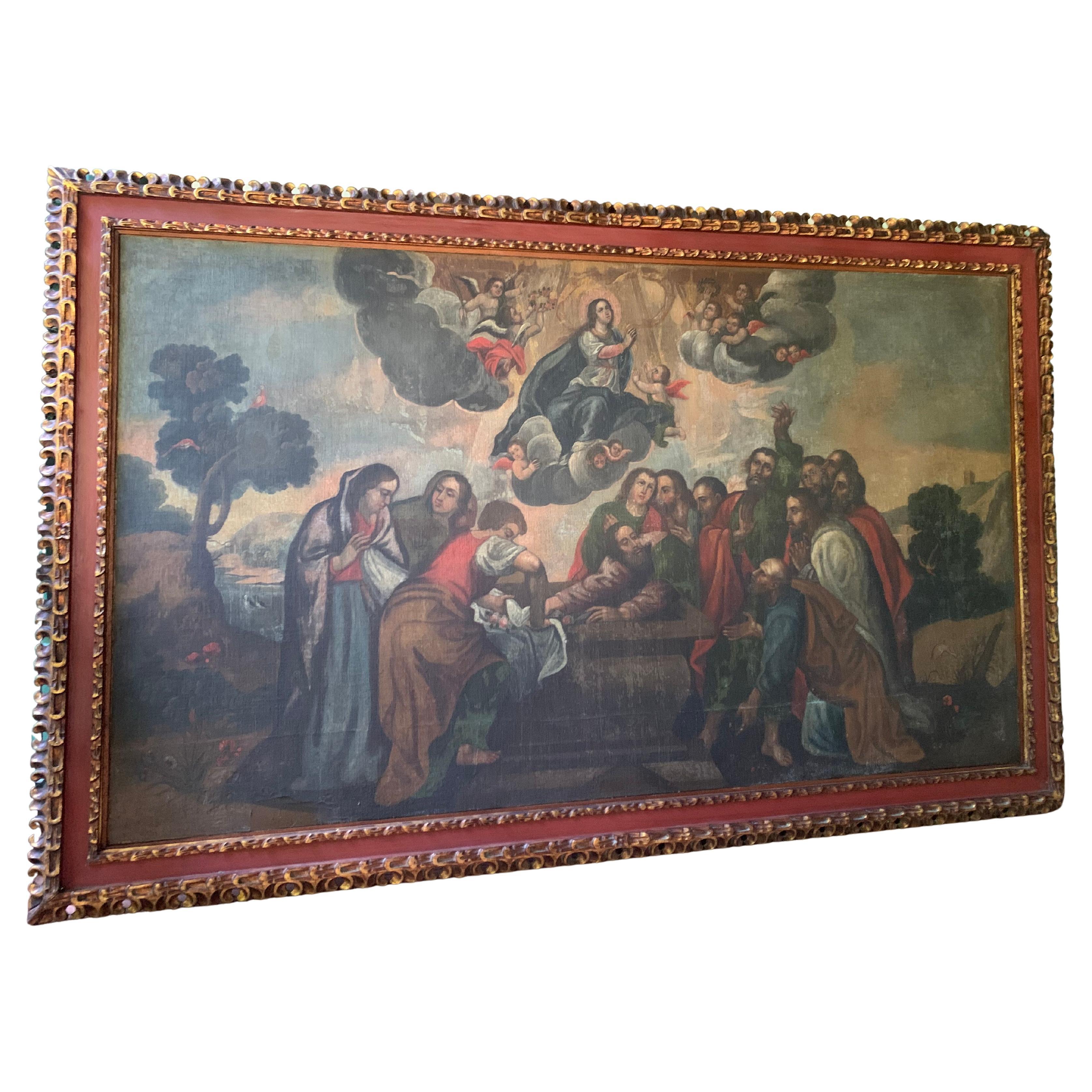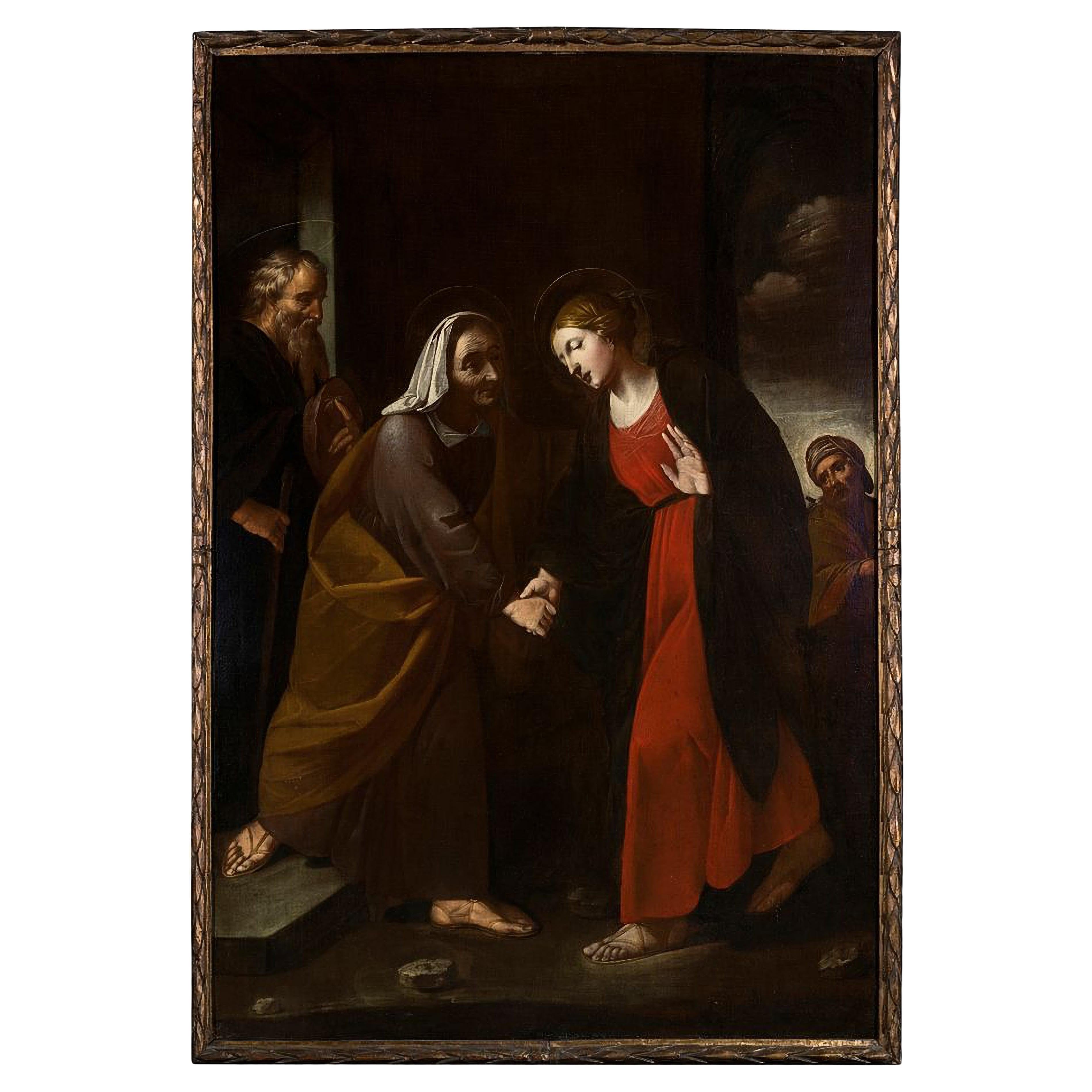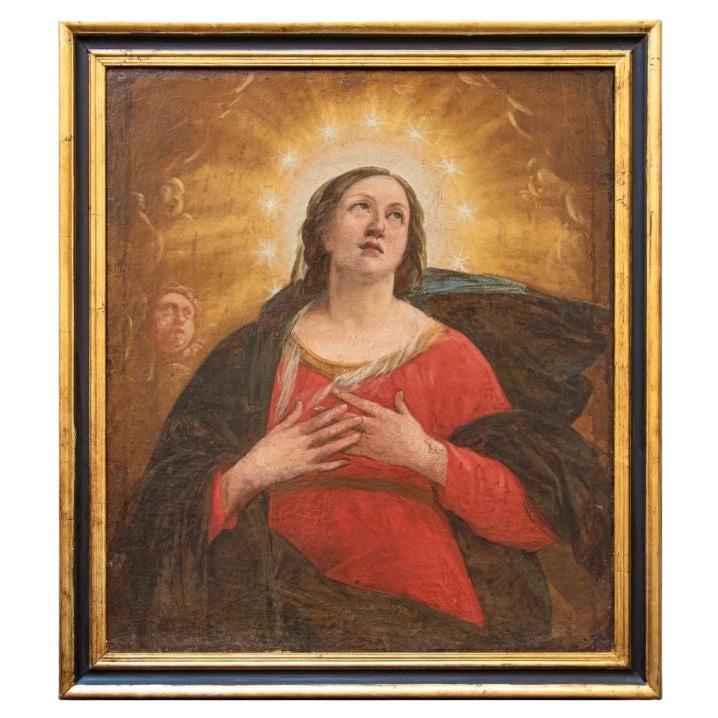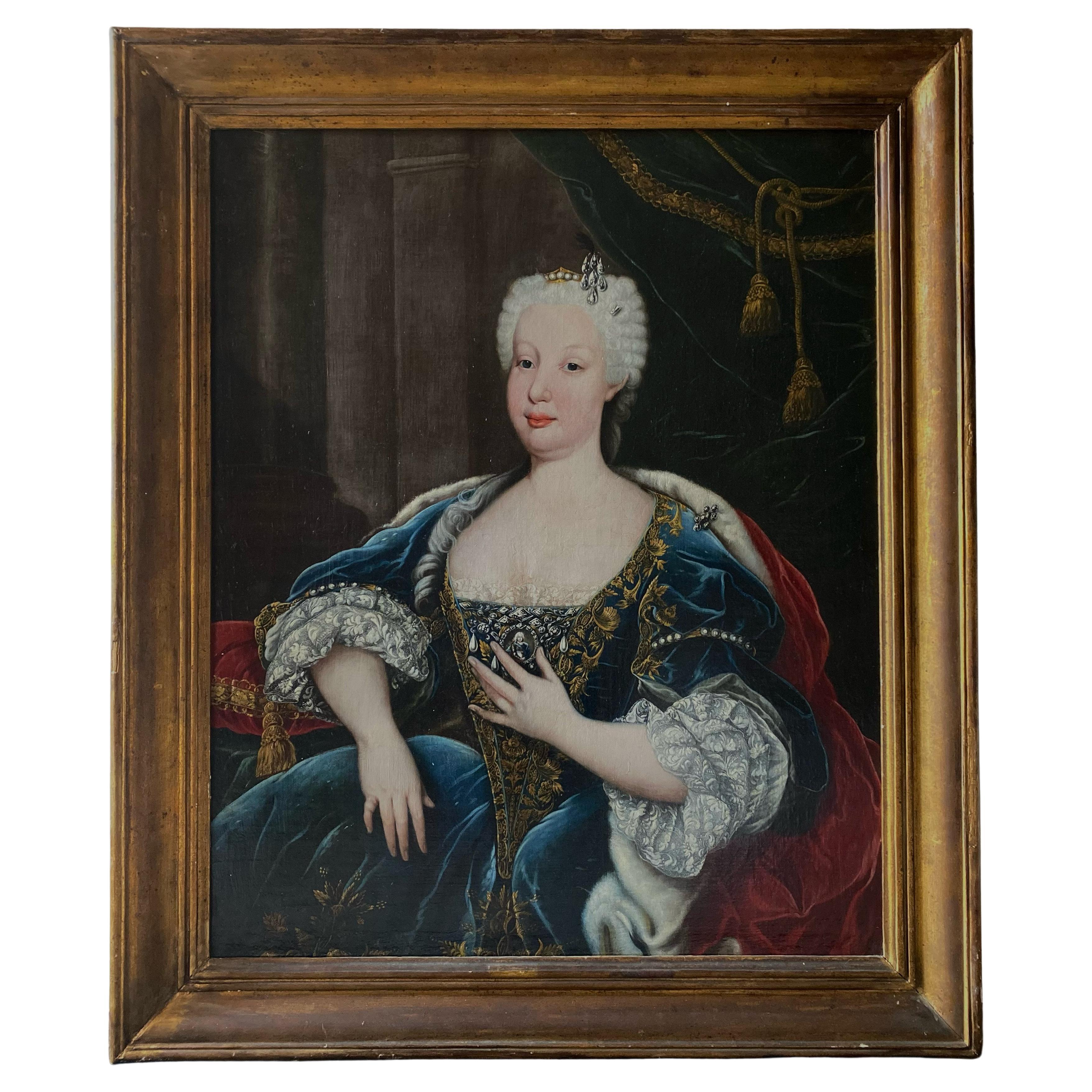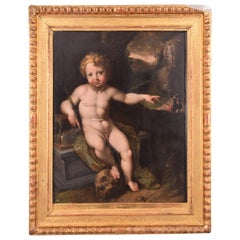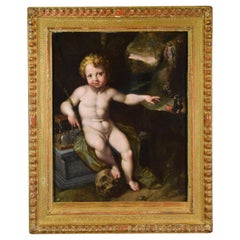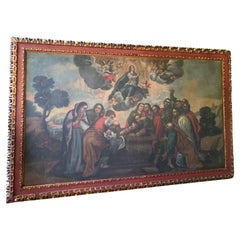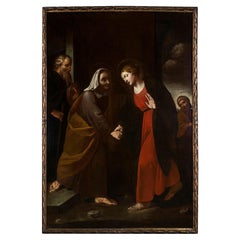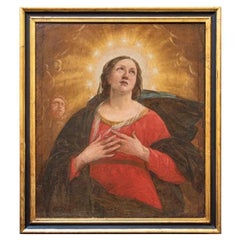Items Similar to Assumption of the Virgin Mary, Circle of Van De Kasteele, Frans
Want more images or videos?
Request additional images or videos from the seller
1 of 8
Assumption of the Virgin Mary, Circle of Van De Kasteele, Frans
About the Item
Circle of VAN DE KASTEELE, Frans (Brussels, c. 1541 – Italy, 1621). "Virgin with angels and saints". Oil on copper. Curly frame in ebony.
Devotional painting, judging by its small format, its theme and also by the fact that it is an oil painting on copper. For this reason, it was surely conceived for an altar or private chapel. It presents a great breaking of central Glory, delimited by cumulus clouds among which the heads of cherubs appear, with the figure of the Virgin Mary in the center, carried by child angels. She wears an intense pink tunic, with a violet tunic underneath, of which we can only see the sleeves, a blue cloak (symbol of truth and eternity) and a white veil over her head, alluding to the concept of purity. Maria appears in a rotating, dynamic and typically baroque position, and shows one hand outstretched towards the ground plane, another on her chest and her head slightly turned, with her eyes directed towards the sky. At his feet, four figures in a landscape environment closed on both sides and open in depth in the center (in the distance we see a city, shrouded in mist and bluish by distance), a balanced, symmetrical and orderly composition typical of the Baroque classicist. It is the representation of Saint James the Greater, Saint John, Saint Francis and Saint Mauritius, from left to right. All of them are represented large, with special attention paid to their anatomies and clothing, worked in typically Baroque chiaroscuro folds. Santiago wears a cloak adorned with a scallop on his shoulder, and carries a staff and a pilgrim's hat. Saint John wears the sheepskin typical of his iconography, a red cloak alluding to his passion, and carries the cruciferous labarum and his Gospel in his hand. At his feet, the lamb that usually accompanies him in plastic representations, a symbol of Christ and his sacrifice. On the right side we see Saint Francis in a brown habit, tied with the Franciscan rope, looking up at Mary and crossing his hands over his chest, showing his stigmata and carrying a wooden crucifix. Finally at his side we see Saint Maurice, with a breastplate and cloak, carrying the palm of martyrdom. The blue and pink tones of her attire are in keeping with the colors of the Virgin's clothing, as is Santiago's purple cloak, a resource by which the painter balances the composition, unifying both planes, and establishes a pyramidal structure. typically classical, balanced and symmetrical. Due to its formal characteristics, we can relate this work to the influence of Frans Van de Kasteele, called Francesco da Castello, a Flemish painter installed in Rome during the pontificate of Gregory XIII (1572-85). Already in 1577 he is documented as a member of the Academy of San Lucas, and in 1588 he was named consul. To this day we know nothing of his training in the Netherlands or of his early works. In a private Viennese collection there is a miniature on parchment signed by the artist and dated 1584, an Adoration of the Magi. Likewise, a contract from 1588 is known in which he was commissioned six paintings on canvas and five miniatures on copper with religious themes. Although installed in Rome, Kasteele always maintained relations with the Netherlands, especially with the humanists Philips van Winghe, Abraham Ortelius and Henricus Corvinus. In Rome he was respected and recognized, a member of the Pantheon of the Academy of the Virtuosos as well as that of Saint Luke. Although he also worked on easel painting, he was mainly the author of small-format works, illuminations, and miniatures. Many of his works were sent to Spain, which is why he had numerous followers in our country.
Size: 33x3x40 cms. int. 24x32 cm
- Attributed to:Francesco da Castello (Artist)
- Dimensions:Height: 15.75 in (40 cm)Width: 13 in (33 cm)Depth: 1.19 in (3 cm)
- Style:Baroque (Of the Period)
- Materials and Techniques:
- Place of Origin:
- Period:Early 17th Century
- Date of Manufacture:circa 1600
- Condition:Wear consistent with age and use. Minor fading.
- Seller Location:Madrid, ES
- Reference Number:Seller: Z50991stDibs: LU295139458253
About the Seller
4.9
Vetted Professional Seller
Every seller passes strict standards for authenticity and reliability
Established in 1985
1stDibs seller since 2017
333 sales on 1stDibs
Typical response time: 8 hours
- ShippingRetrieving quote...Shipping from: Madrid, Spain
- Return Policy
Authenticity Guarantee
In the unlikely event there’s an issue with an item’s authenticity, contact us within 1 year for a full refund. DetailsMoney-Back Guarantee
If your item is not as described, is damaged in transit, or does not arrive, contact us within 7 days for a full refund. Details24-Hour Cancellation
You have a 24-hour grace period in which to reconsider your purchase, with no questions asked.Vetted Professional Sellers
Our world-class sellers must adhere to strict standards for service and quality, maintaining the integrity of our listings.Price-Match Guarantee
If you find that a seller listed the same item for a lower price elsewhere, we’ll match it.Trusted Global Delivery
Our best-in-class carrier network provides specialized shipping options worldwide, including custom delivery.More From This Seller
View AllPair of Miniatures, Frans van de Casteele 'Kasteels' aka Francesco da Castello
By Francesco da Castello
Located in Madrid, ES
Frans van de Casteele (Kasteels) called Francesco da Castello (Brussels, ca. 1541 - Rome, 1621)
Adoration of the shepherds
Crowning with thorns
First decade of the 17th century.
Tempera and gold on parchment, 290 x 240 mm (with frame).
Original wooden frame with trimmed silver foil applications; in the corners, medallions with the four evangelists.
The two refined miniatures of the Adoration of the Shepherds and the Crowning with Thorns are works of the artist's full maturity, dating from the first decade of the 17th century, characterized by formal simplification and pure colors in the invoice of the garments that stand out from the eburoral incarnations of the characters.
Among the numerous motifs comparable to those of other miniatures by Francesco da Castello, the small medallions with the Evangelists barely outlined on a golden background, closely recall the miniatures, of reduced dimensions, inserted in the compartments of the frame of the altar with the Mysteries del Rosario, as well as those of another box with compartments with the Tree of Jesse...
Category
Antique Early 17th Century European Baroque Decorative Art
Materials
Other
Allegory of Time. Oil on panel. Circle of Jacob de Backer (act. 1571-1585).
Located in Madrid, ES
Allegory of Time. Oil on panel. Circle of Jacob de Backer (act. Antwerp, 1571-1585).
Exhibition: “Reality, time and artifice. Still life and vanitas in baro...
Category
Antique 16th Century Belgian Renaissance Paintings
Materials
Other
Portraits of the monarchs Louis XIII and Anne-Marie of Austria as hunters.
Located in Madrid, ES
Portraits of the monarchs Louis XIII and Anne-Marie of Austria as hunters. Oil on canvas. Possibly Madrid school, 17th century.
Pair of full-length portraits showing the characters against natural backgrounds, with landscapes with mountains in the distance and trees. The male character, who looks directly at the viewer, has dark hair and a fine moustache, and is dressed in a ruff, a doublet, leather gloves, a blued breastplate with gold details, breeches, white silk stockings and cavalier boots. The lady, who modestly lowers her gaze, has her head partially covered with a hat decorated with a brooch and white feathers; she is dressed in a ruff and a dress with a wide-skirted doublet and skirt, wide-mouthed gloves and a short cloak with a decorated edge gathered around the left arm and placed over the right side of the skirt. Alongside these “hunting” dresses, they appear carrying firearms and accompanied by large dogs. The king's dog is standing alertly, turning his head to one side. The queen's dog is sitting looking at her, with a collar and a rope that she holds in her left hand. The male subject is clearly the French King Louis XIII (Fontainebleau, 1601-Saint-Germain-en-Laye, 1643), monarch of France and Navarre (1610-1643), son of Henry IV of France and Marie de Médicis and father of Louis XIV of France. Compare with other portraits: by Rubens, painted around 1622-1625 at the Norton Simon Museum (Pasadena, California, USA); by Philippe de Champaigne, painted in 1635 and kept at the Museo del Prado (Madrid, Spain); the painting by Frans Pourbus the Younger from the 1920s at the Musée des Beaux-Arts in Chambéry (France); etc. Louis XIII married Anne of Austria, daughter of Philip III of Spain, in 1615. This was brought about by the marriage agreement of Fountainebleau (1611), which stipulated the future wedding of the Prince of Asturias, Philip IV, with the French princess Isabella of Bourbon, and that of the French monarch with Anne. Anne Maria Mauricia of Austria and Austria-Styria (Valladolid, 1601-Paris, 1666) was an Infanta of Spain and Portugal as the daughter of Philip III of Spain and Margaret of...
Category
Antique 17th Century Spanish Baroque Paintings
Materials
Other
Vanitas, Oil on Panel, Circle of Vincent Sellaer 'c. 1500-Mechelen, before 1589'
Located in Madrid, ES
Vanitas. Oil on panel. Surroundings by Vincent Sellaer (c. 1500-Mechelen, before 1589).
Oil on canvas that shows, on a background with trees and hills, a child figure sitting on a ...
Category
Antique 16th Century European Renaissance Paintings
Materials
Other
Sacrifice of the Mosaic Law. Oil on copper. 17th century, after RUBENS.
Located in Madrid, ES
Sacrifice of the Mosaic Law. Oil on copper. 17th century, inspired by RUBENS, Pedro Pablo (Siegen, 1577-Antwerp, 1640).
Oil on panel showing a figurative scene located in a building...
Category
Antique 17th Century Spanish Baroque Paintings
Materials
Copper, Other
The temptation of St Anthony. Oil on canvas. 17th c., after David Teniers II
By David Teniers the Younger
Located in Madrid, ES
Temptations of San Antonio Abad. Oil on canvas. 17th century, following the model of David Teniers II (Antwerp, 1610-Brussels, 1690).
Oil on canvas showing a figurative scene located inside a cave. To the right, you can see a cross standing, supported; to the left, a hut; and in the center of the painting appears an elderly, bearded man, leaning on a table on which there is a ceramic jug and a skull, with an open book at the foot of it. The man looks towards a woman, who points to something outside, and appears accompanied by a large frog and a series of ghostly beings or monsters dressed in brightly colored cloth and clothing.
San Antonio Abad or Antonio Magno (251-356) was a Christian monk, considered the founder of the eremitical movement. He was tempted numerous times by the devil while he was in the desert, becoming a subject frequently represented in art (as can be seen in this oil painting). He is represented in a black habit because the Order of the Knights of the Hospital of San Antonio (Hospitals) was placed under his patronage, being the color of the habits of the members of this order (the tau or Egyptian cross was also the symbol chosen by they).
David Teniers II or El Joven was a prominent Flemish painter and engraver, son of David Teniers El Viejo or I and father of David Teniers III, much appreciated at the time for his scenes of villagers and common people, his paintings of monkey painters, etc. . He dealt with the theme of the Temptations of Saint Anthony...
Category
Antique 17th Century European Baroque Paintings
Materials
Other
You May Also Like
A large 19th-century Orthodox icon of the Assumption of the Virgin Mary
Located in Belgrade, RS
An imposing religious-themed painting depicts the scene of the "Assumption of the Virgin". The iconography in this 19th-century painting follows the tendencies of Baroqueization and ...
Category
Antique Late 19th Century Serbian Baroque Paintings
Materials
Canvas, Wood, Giltwood
The Assumption of Mary or Dormition of the Virgin 18th Century Spanish Colonial
Located in Rio De Janeiro, BR
This magnificent 18th-century Spanish Colonial oil painting is a remarkable example of religious art, showcasing a stunning depiction of the Dormition of the Virgin. Measuring grandl...
Category
Antique Early 18th Century Peruvian Spanish Colonial Paintings
Materials
Canvas
Massimo Stanzione (1585 - 1656) Circle of Visitation Virgin Mary with Expertise
Located in Madrid, ES
Massimo Stanzione (Frattamaggiore or Orta di Atella 1585 - Naples 1656) circle of
Visitation of the Blessed Virgin Mary to her cousin Saint Elizabeth
Oil on canvas
147 x 100 cm
Writ...
Category
Antique Early 17th Century Italian Baroque Paintings
Materials
Paint
17th Century Virgin of the Assumption Painting Oil on Canvas
Located in Milan, IT
17th century
Virgin of the Assumption
Oil on canvas, 93 x 81 cm
Frame, 110 x 97 cm
The present Assumption of the Virgin welcomes an innova...
Category
Antique 17th Century Italian Paintings
Materials
Canvas
Portrait of D. Maria Bárbara De Bragança, Circle of Louis-Michel Van Loo
By H. van Loon
Located in Lisboa, PT
PORTRAIT OF D. MARIA BÁRBARA DE BRAGANÇA (1711-1758), QUEEN OF SPAIN
Circle of Louis-Michel van Loo (1707-1771)
Oil on canvas
Her Royal Highness, the Infanta Maria Barbara of Braganza (1711-1758) was the first-born child of King John V of Portugal (1689-1750) and his queen consort Maria Anna of Austria (1683-1754). Born in December 1711, she had the Convent Palace of Mafra built in her honour following a vow made by her royal father. Her status as Princess of Brazil, inherent to 18th century Portuguese presumptive heirs, would however be superseded once the queen gave birth to two male princes, D. Pedro (1712-1714) and D. José (1714-1777), preventing her from ascending to the throne.
Daughter of one of the most illustrious monarchs of his time, Maria Barbara was carefully educated to become a fond admirer of the arts, and of music in particular, having had the Italian composer Domenico Scarlatti (1685-1757) as her music teacher.
On the 10th January 1723 the young princess was betrothed to the Infante Ferdinand of Spain (1713-1759), eldest son of King Philip V (1683-1746). Six years later, on the 19th January, she entered her new country in a carefully choreographed ceremony that became known to history as the “Exchange of the Princesses”. This unique event took place on a specially built Bridge-Palace, a wooden, luxuriously decorated structure that included various modules and rooms, on both banks of the river Caia, the natural border between the town of Elvas in Portugal and of Badajoz in Spain. Simultaneously, on the same day that the Portuguese Infanta crossed the border to marry the Spanish Crown Prince, her new sister in law, the Infanta Mariana Victoria of Bourbon (1718-1781), her husband’s sister, crossed the same bridge in the opposite direction to marry Prince D. José, the Portuguese heir to the throne.
Once married, Maria Barbara would spend 17 years as Princess of Asturias, only becoming Queen of Spain at her husband’s accession following the death of Philip V in 1746. She is portrayed in the 1743 painting by Louis-Michel van Loo (1707-1771) now in the Prado Museum, in which Philip V had himself represented with all his close family.
The new Queen would take an important role at court eventually becoming the liaison between her husband and the King of Portugal, particularly throughout the negotiations for the Treaty of Madrid (1746-1750). Maintaining her interest in music, she patronized the Italian castrato singer Farinelli (1705-1782) while remaining close to her old master Scarlatti, having herself composed some sonatas for a large orchestra. She would also commission and fund the building of the Royal Salesians Monastery complex in central Madrid, where both her and Ferdinand VI are buried.
The portrait we are presenting for sale shows the Queen in half-length, turning left at three quarters. She is wearing a blue low-cut dress embroidered with flowers and foliage, over a lace cuffed white blouse, and an ermine cloak pined on the left-hand side by a diamond broach. The powdered hair style is held sideways by a seven diamond and black plume headdress and topped by a small gold and pearl crown. The right arm rests on a cushion while the left hand, at chest height, holds a miniature male portrait.
The Infanta’s features are analogous to the 1725 portrait by the painter Domenico Duprà (1689-1770), also in the Prado Museum collection. Further similarities can be found in another portrait by Louis-Michel van Loo, in which a seven diamond and black plume headdress is also present. In this work, the cushion supporting Maria Barbara’s right arm has also some obvious similarities to our painting. The same diamond headdress reappears in Van Loo’s above-mentioned portrait of Philip V’s family dated from 1743.
It is nevertheless in Lisbon’s Ajuda National Palace that it is possible to find an almost identical depiction of the Infanta holding a miniature portrait of her husband. In it, the future Ferdinand VI is portrayed facing right at three quarters and wearing a curly wig, suit of armour, the golden fleece insignia and a blue band, in a composition that closely resembles an 18th century Spanish school painting that appeared in the art market in January 2016.
Another detail common to various portraits of the Portuguese Infanta and Queen of Spain is the small gold and pearl crown on her head. In another Van Loo painting, also from the Prado Museum, in which Maria Barbara is portrayed as Queen, this crown is represented together with a headdress similar to the one previously described. Another two paintings by the same artist, at the Royal Academy of Saint Ferdinand, include the same ornament.
We must also refer the paintings by the artist Jean Ranc (1674-1735). In one, dating from 1729 (Prado Museum), the Infanta is depicted outdoors holding a flower bouquet and wearing a yellow silk dress with red cloak, and a set of diamond and ruby jewellery that includes a headdress similar to the one present in our portrait. Another work by the same artist, belonging to the Complutence University of Madrid, depicts the Infanta sumptuously dressed in identical colours to our painting and wearing an elaborate headdress and diadem.
These portraits, beyond their iconographical importance as contemporary records of the Infanta and Queen Maria Barbara, are also illustrative of 18th century fashion for jewelled head dressing. Often, flowers were combined with joyful adornments, composing almost theatrical displays that would reinforce the ostentatious nature of the image. The ornamental flowers and the chromatic character of the jewels would complement the luxury of the colourful dresses in blue, crimson, green or other silk shades, in compositions whose sole purpose was to highlight a royal sitter’s wealth and power, becoming an essential statement accessory within the strict court protocols and codes of conduct.
Circle of Louis-Michel van Loo (1707-1771)
Slowly but steadily, the resolute, tranquil and dignified attitude of Renaissance and Baroque portraiture becomes artificial and presumptuous. Mid 18th century society favours elusive expression and psychological deepness, albeit limited to the face, that, with emphasis on detail, on the rich colour palette and on changing costumes and landscapes, associated to the courtliness of gestures, creates a strongly artificial environment while maintaining a highly poetic intrinsic character.
Louis-Michel van Loo followed a dynasty of famous Dutch origin artists that had settled in France. Initially taught by his father, Jean-Baptiste von Loo (1684-1745), the younger van Loo studied in Turin and Rome and frequented the Paris Academy. In Rome he worked with his uncle Charles-André van Loo (1705-1765) and become a painter for the Turin Court. In 1737 he arrived in Spain being summoned by Philip V to succeed Jean Ranc as painter of the king’s chamber.
In Madrid, his work covers the numerous Court commissions and the Royal Saint Ferdinand Fine Arts Academy, of which he was a founding member and director for the Painting department in 1752. Is production at court consisted essentially of numerous portrait paintings, often Royal gifts...
Category
Antique 18th Century Spanish Baroque Paintings
Materials
Canvas
Painting of the Virgin Mary Holding Baby Christ (Cusco, Peru)
Located in Royal Tunbridge Wells, Kent
A fine 18th century painting depicting the Virgin Mary holding baby Christ above four saints, painted in the artistic centers of Cuzco and the Altiplano re...
Category
Antique 18th Century Peruvian Paintings
Materials
Canvas, Paint
